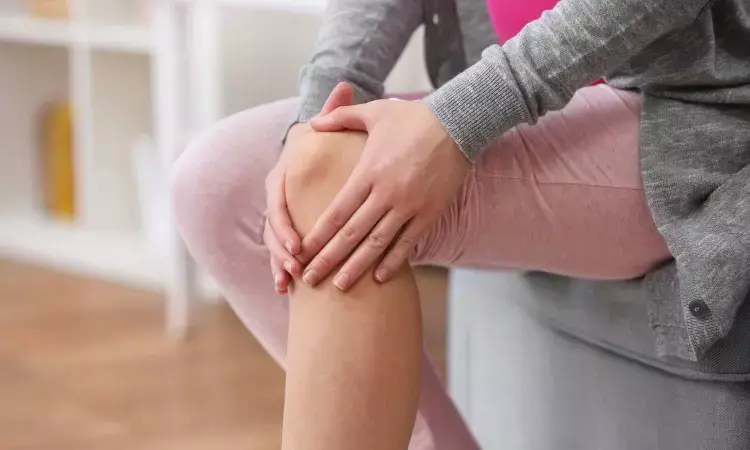- Home
- Medical news & Guidelines
- Anesthesiology
- Cardiology and CTVS
- Critical Care
- Dentistry
- Dermatology
- Diabetes and Endocrinology
- ENT
- Gastroenterology
- Medicine
- Nephrology
- Neurology
- Obstretics-Gynaecology
- Oncology
- Ophthalmology
- Orthopaedics
- Pediatrics-Neonatology
- Psychiatry
- Pulmonology
- Radiology
- Surgery
- Urology
- Laboratory Medicine
- Diet
- Nursing
- Paramedical
- Physiotherapy
- Health news
- Fact Check
- Bone Health Fact Check
- Brain Health Fact Check
- Cancer Related Fact Check
- Child Care Fact Check
- Dental and oral health fact check
- Diabetes and metabolic health fact check
- Diet and Nutrition Fact Check
- Eye and ENT Care Fact Check
- Fitness fact check
- Gut health fact check
- Heart health fact check
- Kidney health fact check
- Medical education fact check
- Men's health fact check
- Respiratory fact check
- Skin and hair care fact check
- Vaccine and Immunization fact check
- Women's health fact check
- AYUSH
- State News
- Andaman and Nicobar Islands
- Andhra Pradesh
- Arunachal Pradesh
- Assam
- Bihar
- Chandigarh
- Chattisgarh
- Dadra and Nagar Haveli
- Daman and Diu
- Delhi
- Goa
- Gujarat
- Haryana
- Himachal Pradesh
- Jammu & Kashmir
- Jharkhand
- Karnataka
- Kerala
- Ladakh
- Lakshadweep
- Madhya Pradesh
- Maharashtra
- Manipur
- Meghalaya
- Mizoram
- Nagaland
- Odisha
- Puducherry
- Punjab
- Rajasthan
- Sikkim
- Tamil Nadu
- Telangana
- Tripura
- Uttar Pradesh
- Uttrakhand
- West Bengal
- Medical Education
- Industry
Both high- and low-intensity exercise therapy beneficial for knee osteoarthritis

A randomized controlled trial comparing high- and low-dose exercise therapy for patients with knee osteoarthritis found that both types of exercise therapy produced similar outcomes in pain, function, and quality of life. High-dose therapy provided superior outcomes related to function in sports and recreation in the short term, with results subsiding after 6 months. The findings are published in Annals of Internal Medicine.
Knee osteoarthritis is associated with chronic pain, knee stiffness, decreased function, and reduced quality of life. The preferred treatment is exercise therapy, including medical exercise therapy, which consists of self-paced exercises set by the patient and a physiotherapist. The type, intensity, duration, and frequency of these exercises can be categorized as low- or high-dose. Studies of other patient populations with conditions including diabetes and cardiovascular disease have demonstrated positive dose-response relationships to exercise, but this is not true of musculoskeletal pain.
Using a non-superiority design, researchers from the Karolinska Institutet, Holten Institute, Sweden, and Norwegian University of Science and Technology, and Rosenborg Fysioterapiklinikk, Norway, randomly assigned 189 persons with knee osteoarthritis with pain and decreased function to either low- or high-dose exercise therapy to compare exercise dose response with regard to knee function, pain and quality of life. The researchers hypothesized that exercise at a higher dose would produce superior outcomes in this patient population.
Results were measured using the Knee Injury and Osteoarthritis Outcome Score (KOOS) biweekly for 3 months and then again at 6 and 12 months. At all follow-up periods, KOOS scores improved in both groups, findings that did not support the authors’ hypothesis. The only differences favoring high-dose exercise were in the domain of knee function during sports and recreation at the end of treatment and 6 months after the intervention and in the quality-of-life domain at 6 months. The authors note that high-dose treatment could be preferable to low-dose treatment in the long run for people who lead active lives. However, adherence could be an issue, as those in the low-dose group had nearly perfect adherence to the intervention, while the high-dose participants had a higher drop-out rate.
Reference:
Tom Arild Torstensen, Håvard Østerås, Riccardo LoMartire, Georg Mørtvedt Rugelbak, Wilhelmus Johannes Andreas Grooten, and Björn Olov Äng, https://doi.org/10.7326/M22-2348
Dr Kamal Kant Kohli-MBBS, DTCD- a chest specialist with more than 30 years of practice and a flair for writing clinical articles, Dr Kamal Kant Kohli joined Medical Dialogues as a Chief Editor of Medical News. Besides writing articles, as an editor, he proofreads and verifies all the medical content published on Medical Dialogues including those coming from journals, studies,medical conferences,guidelines etc. Email: drkohli@medicaldialogues.in. Contact no. 011-43720751


